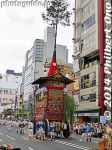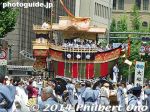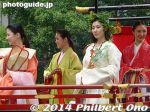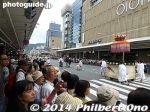 Image search results - "Parade" Image search results - "Parade" |

Nicknamed Little Edo (Koedo), the castle town of Hikone holds the annual Little Edo Hikone Castle Festival Parade on Nov. 3 from 1 pm to 3 pm.Very elaborate costume parade of mainly kids dressed as samurai and Edo-Period ladies. Highlights include the Hikone Gun Battalion giving a matchlock gun demo (in front of Horse Stable), Ii Naosuke played by an actor on horseback, fireman acrobatics, and Sarugaku dancers. The parade route starts from Joto Elementary School and proceeds along the road to the castle and passes in front of the Umaya Horse Stable. Short walk from JR Hikone Station. Parade route map:
http://www.hikoneshi.com/jp/event/articles/c/parade
Photo: Statue of Lord Ii Naomasa in front of Hikone Station.
|
|

The main highlight of the festival is the Hikone Castle Festival Parade held in the afternoon of Nov. 3 (national holiday called Culture Day).
|
|

The parade has children and adults dressed in historical costumes, especially the red samurai armor which was the trademark of the Ii clan. Even a modern samurai needs a cell phone.
|
|

Castle parade route to Hikone Castle.
|
|

These photos were taken on Nov. 3, 2009.
|
|

Start of the Hikone Castle Parade on Nov. 3. Boy Scouts help out by carrying signs.
|
|

Military band
|
|

Dream Ambassador from Takamatsu, Kagawa Pref.
|
|

Miss Plum Blossom from Mito, Ibaraki Pref. Mito's connection with Hikone lies in the radical samurai who assassinated Ii Naosuke near Edo Castle.
|
|

Flags from sister cities.
|
|

Miss Hikone Castle
|
|

Miss Hikone Castle
|
|

Tourist Site Clean Campaign
|
|

Kawase Junior and Senior High School band.
|
|
|
|

Asahinomori Elementary School in Hikone.
|
|

Hikone Gun Battalion whose members are licensed to fire matchlock guns.
|
|

Hikone Gun Battalion dressed like Ii Clan samurai with their trademark red armor nicknamed "Red Devils."
|
|

Hikone Gun Battalion
|
|

Little Edo Hikone Castle Festival Parade
|
|

Ii Naosuke procession
|
|

Ii Naosuke is portrayed by an actor.
|
|

Ii Naosuke (井伊 直弼) (1815-1860) as the Tokugawa shogunate's Chief Minister (Tairo) who favored and concluded commercial treaties with the Western powers and thus broke Japan's isolation from the world.
|
|

Next are groups wearing period costumes. They are junior high schoolers.
|
|

Heian Period (794-1185) women wearing veiled straw hats called ichime-gasa. 市女笠
|
|

A few foreigners too.
|
|
|
|
|
|

Samurai laborers carrying luggage for a traveling daimyo.
|
|
|
|
|
|

Chief retainer who started the construction of Hikone Castle upon the wishes of Ii Naomasa. 家老の木俣守勝
|
|
|

A daimyo
|
|
|
|

Samurai wives
|
|
|
|

Shrine maidens from Izumo
|
|

Dancers from Muromachi Period (1337-1573)
|
|
|

Kamakura Period (1185–1333) women wearing veiled straw hats called ichime-gasa. 市女笠
|
|
|

Shirabyoshi dancers from the Heian Period.
|
|
|

Katsugi veiled kimono worn by the nobility in the Muromachi Period.
|
|
|

Soldiers from the Ii clan.
|
|

Ii Clan's "Red Devil" samurai vassals wearing their trademark red armor.
|
|

Banners with the crest of the Ii clan.
|
|

Ii clan warriors
|
|
|
|
|
|
|

Ii Naomasa (井伊直政) (1561-1602 ) was the first lord of Hikone from 1600. He was a general under Tokugawa Ieyasu whom he helped to win the Battle of Sekigahara in 1600. He was rewarded with the fief of Omi (now Shiga) and built Hikone Castle.
|
|
|
|
|
|
|
|
|
|

Ii Naotaka
|
|
|

The Hikone Gun Battalion in formation for a firing demo.
|
|
|
|
|

They fire their matchlock guns.
|
|

The matchlock guns make a huge bang.
|
|

Hiko-nyan
|
|

Hiko-nyan is Hikone's official mascot. A white cat wearing a samurai helmet modeled after Ii Naomasa.
|
|

Sitting like royalty, local politicians such as the mayor sit in a special stand on the right in front of the horse stable. The rest of us stand and watch like peasants.
|
|
|

Hikone Traditional Fireman Preservation Group
|
|

Firemen
|
|

Fireman's ladder
|
|

They hoist up the ladder for someone to climb up.
|
|

Fireman's ladder acrobatics
|
|
|

Fireman's acrobatics is a crowd pleaser.
|
|
|

Sarugaku entertainers from the Omi Sarugaku Taga-za troupe. 猿楽
|
|

Sarugaku is a centuries-old form of entertainment and a precursor to Noh and Kyogen.
|
|

Foreigners carry the shishimai lion heads, but they did not perform with it.
|
|
|
|
|
|
|
|
|
|
|
|
|
|
|
|

Dragon dance
|
|
|
|
|
|
|
|

Shishimai lion dance
|
|
|
|
|
|
|
|
|
|

Finally at 7:30 pm, the main event called Dancing Soda Night started along Route 13 and Ekimae-dori.
|
|
|
|
|
|
|
|

School girls
|
|
|
|
|
|

Many of the dance groups were from dance studios or schools.
|
|
|

Fukushima Waraji Matsuri
|
|

Fukushima Waraji Matsuri
|
|

Eisa group from Okinawa
|
|
|

At the intersection. Notice the giant waraji straw sandal.
|
|

Some fireworks
|
|
|

Awards ceremony. The festival ended at about 9:30 pm.
|
|

The start of the Gion Matsuri Ato Matsuri yama-hoko procession on July 24, 2014. Held 1 week after the main Saki Matsuri procession on July 17.
|
|

Hashi Benkei-yama 橋弁慶山 - From the famous Noh play called "Hashi Benkei," it shows the fight scene between Benkei and Ushiwakamaru at Gojo Ohashi Bridge in Kyoto.
|
|

Kita Kannon-yama 北観音山 - Worships Yoryu Kannon (揚柳観音) to dispel illness, and Idaten, a guardian deity.
|
|

A large willow branch sticks out from the rear.
|
|
|
|

Hachiman-yama 八幡山 - Worships the god Hachiman in a miniature shrine, whose spirit was transferred from the local Hachiman-gu shrine.
|
|
|

Kawaramachi-dori going to Shijo-dori road.
|
|

Jomyo-yama 浄妙山
|
|

Jomyo-yama 浄妙山
|
|
|

Jomyo-yama 浄妙山 - Depicts the famous 12th-century battle between the Heike and Genji Clans at Uji River in Kyoto in the Tale of the Heike. It shows warrior-monk Ichirai jumping over Jomyo to take credit as the first to engage the enemy.
|
|
|
|

Suzuka-yama 鈴鹿山 - Dedicated to the goddess Suzuka who lives in the Suzuka Mountains and eliminated the demon terrorizing local residents and travelers to Ise. She wears a gold eboshi hat.
|
|

Minami Kannon-yama about to turn at the Kyoto City Hall corner.
|
|

Minami Kannon-yama 南観音山 - Worships Yoryu Kannon (揚柳観音), which dispels illness. The large willow branch also dispels illness. Medicine balls are on the four corners.
|
|
|
|

Koi-yama 鯉山 - Shows a carp (koi) swimming up a ryumon waterfall to become a dragon. The tapestries, depicting the Trojan War, were made in Belgium in the 16th century. (Important Cultural Properties)
|
|

En no Gyoja-yama 役行者山 - Depicts En-no-Gyoja, in the middle, an ascetic who had Hitokoto Nushi (standing on left) build a stone bridge between Katsuragi and Mt. Omine in Nara. On the right is the Goddess Katsuragi.
|
|

Kuronushi-yama 黒主山 - From the Noh play called "Shiga," it shows 10th-century poet Otomo no Kuronushi looking up at cherry blossoms.
|
|

Ofune-hoko 大船鉾 - Gion Matsuri's brand new float parading for the first time today on July 24, 2014.
|
|

Costing over US$10 million, this float always appears last in the Ato Matsuri. It rejoins the Gion Matsuri after being absent for 150 years when the previous float was caught in a fire in 1864.
|
|
|
|

The new boat float (Ofune-hoko) rejoins the Gion Matsuri after a 150-year absence. It always appears last in the float procession.
|
|

Meet Gion Matsuri's new boat float, Ofune-hoko.
|
|

During the Ofune-hoko's 500-year history, it repeatedly suffered from fires, but was rebuilt each time until 1864 when it caught fire caused by a skirmish (Hamaguri Gate Rebellion 蛤御門の変) at the Kyoto Imperial Palace.Notice the boat rudder.
|
|

Gion Matsuri now has two boat floats. The boat float (Fune-hoko) in the Saki Matsuri procession is said to be going to battle, while the Ofune-hoko is on a triumphant return from battle. Both boat floats worship the legendary Empress Jingu.
|
|

The Hanagasa Parade (花傘巡行) is a parade of mostly children and women accompanied by flowery parasol floats. It starts (10 am) and ends (noon) at Yasaka Shrine. On Kawaramachi-dori road, they follow right after the main float procession.
|
|

When the Saki Matsuri and Ato Matsuri's processions were combined on July 17, 1966, the Hanagasa Parade was started on July 24, 1966 to compensate for the Ato Matsuri's procession.
|
|
|
|
|
|
|
|
|
|
|
|

Hanagsa beauties.
|
|

The parasol floats are reminiscent of Gion Matsuri's earliest floats.
|
|

Kimono beauties
|
|

Geisha/geiko from Miyagawa-cho.
|
|

Geisha/geiko from Miyagawa-cho.
|
|

Geisha/geiko from Miyagawa-cho.
|
|

Geisha/geiko from Gion Kobu
|
|

Geisha/geiko from Gion Kobu.
|
|

Geisha/geiko from Gion Kobu.
|
|

Geisha/geiko from Gion Kobu.
|
|

Geisha/geiko from Gion Kobu.
|
|

Geisha/geiko from Gion Kobu.
|
|

Heron dancers
|
|

Lantern dancers
|
|
|
|
|

Shijo-dori
|
|

Shijo-dori going to Yasaka Shrine.
|
|

The 16th Kitamachi Awa Odori was held on July 26, 2008 from 6 pm to 8:30 pm. Kitamachi is a small neighborhood near Tobu-Nerima Station on the Tobu Tojo Line.
|
|

They danced on the main shopping streets called Kitamachi shotengai (pictured here) and New Kitamachi shotengai. Just few minutes walk from the train station. きたまち商店街
|
|

After a few speeches and a "tape-cut" ceremony, the festival began at 6:30 pm.
|
|

Twenty-three dancing and non-dancing troupes participated. This is somewhat small compared to bigger Awa Odori dances in Tokyo, but the enjoyment and enthusiasm of the dancers and crowd were top-class.
|
|

One group was from the local junior high school.
|
|

There were about 1,400 dancers and about 70,000 spectators lining the streets.
|
|
|

Junior high school dancers dressed in yukata.
|
|

School baseball team, Kitamachi Faiyers. No dancing.
|
|
|
|
|
|
|
|
|

Would you believe a karate group? They did not dance. Just punched and yelled their way through. Kitamachi Awa Odori, Nerima, Tokyo 極真空手連
|
|

I much prefer the women dancers.
|
|

So photogenic, like a crane in flight.
|
|
|
|

Daikon-ren from Nerima-ku.
|
|
|

These kids were very good at the taiko drums.
|
|
|
|
|
|
|
|
|
|
|
|
|
|
|
|

Dancing in formation.
|
|
|

Aoi Shin-ren, one of my favorite Awa Odori troupes. 葵新連
|
|
|
|
|
|
|
|
|
|

Kitamachi Awa Odori, Tokyo 写楽連
|
|

Kitamachi Awa Odori, Tokyo
|
|
|
|

Takara-bune-ren 宝船連
|
|

She loved to pose for photographers.
|
|
|
|
|
|

They were hoppin'
|
|
|
|

Awa Odori dancer
|
|

All the dancers' faces were glistening with perspiration.
|
|

Kitamachi Awa Odori, Nerima-ku, Tokyo
|
|
|

Kitamachi Awa Odori Dance, Nerima-ku, Tokyo きたまち阿波おどり
|
|

Nice formation.
|
|
|

They know how to look good.
|
|
|
|